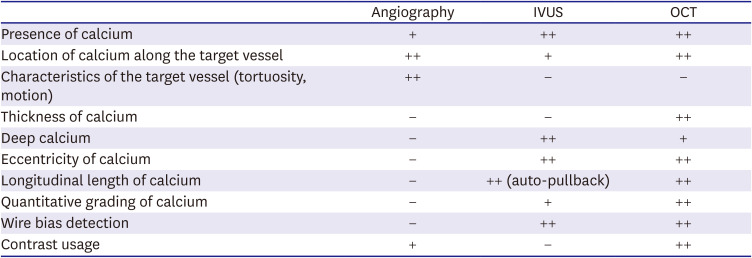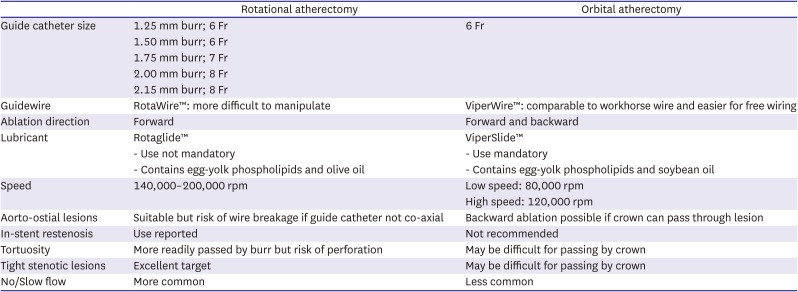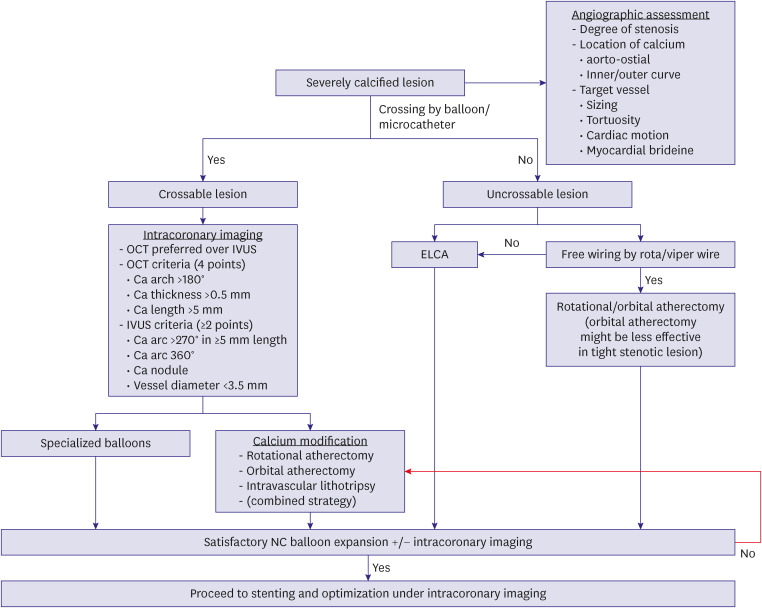1. Généreux P, Madhavan MV, Mintz GS, et al. Ischemic outcomes after coronary intervention of calcified vessels in acute coronary syndromes. Pooled analysis from the HORIZONS-AMI (Harmonizing Outcomes With Revascularization and Stents in Acute Myocardial Infarction) and ACUITY (Acute Catheterization and Urgent Intervention Triage Strategy) trials. J Am Coll Cardiol. 2014; 63:1845–1854. PMID:
24561145.
2. Bourantas CV, Zhang YJ, Garg S, et al. Prognostic implications of coronary calcification in patients with obstructive coronary artery disease treated by percutaneous coronary intervention: a patient-level pooled analysis of 7 contemporary stent trials. Heart. 2014; 100:1158–1164. PMID:
24846971.
3. Kato M, Dote K, Sasaki S, et al. Presentations of acute coronary syndrome related to coronary lesion morphologies as assessed by intravascular ultrasound and optical coherence tomography. Int J Cardiol. 2013; 165:506–511. PMID:
21962801.
4. Otsuka F, Sakakura K, Yahagi K, Joner M, Virmani R. Has our understanding of calcification in human coronary atherosclerosis progressed? Arterioscler Thromb Vasc Biol. 2014; 34:724–736. PMID:
24558104.
5. Bild DE, Detrano R, Peterson D, et al. Ethnic differences in coronary calcification: the Multi-Ethnic Study of Atherosclerosis (MESA). Circulation. 2005; 111:1313–1320. PMID:
15769774.
6. Abedin M, Tintut Y, Demer LL. Vascular calcification: mechanisms and clinical ramifications. Arterioscler Thromb Vasc Biol. 2004; 24:1161–1170. PMID:
15155384.
7. Kim JS, Hwang HS. Vascular calcification in chronic kidney disease: distinct features of pathogenesis and clinical implication. Korean Circ J. 2021; 51:961–982. PMID:
34854578.
8. Criqui MH, Denenberg JO, Ix JH, et al. Calcium density of coronary artery plaque and risk of incident cardiovascular events. JAMA. 2014; 311:271–278. PMID:
24247483.
9. Vliegenthart R, Oudkerk M, Hofman A, et al. Coronary calcification improves cardiovascular risk prediction in the elderly. Circulation. 2005; 112:572–577. PMID:
16009800.
10. Greenland P, LaBree L, Azen SP, Doherty TM, Detrano RC. Coronary artery calcium score combined with Framingham score for risk prediction in asymptomatic individuals. JAMA. 2004; 291:210–215. PMID:
14722147.
11. Raggi P. Prognostic implications of absolute and relative calcium scores. Herz. 2001; 26:252–259. PMID:
11479937.
12. Blankstein R, Budoff MJ, Shaw LJ, et al. Predictors of coronary heart disease events among asymptomatic persons with low low-density lipoprotein cholesterol MESA (Multi-Ethnic Study of Atherosclerosis). J Am Coll Cardiol. 2011; 58:364–374. PMID:
21757113.
13. Sharma SK, Bolduan RW, Patel MR, et al. Impact of calcification on percutaneous coronary intervention: MACE-trial 1-year results. Catheter Cardiovasc Interv. 2019; 94:187–194. PMID:
30681262.
14. Beohar N, Kaltenbach LA, Wojdyla D, et al. Trends in usage and clinical outcomes of coronary atherectomy: a report from the National Cardiovascular Data Registry CathPCI Registry. Circ Cardiovasc Interv. 2020; 13:e008239. PMID:
31973557.
15. Popma J, Bashore T. Qualitative and quantitative angiography. Topol E, editor. Interventional Cardiology. Philadelphia (PA): WB Saunders;1993. p. 1052–1068.
16. The GUIDE Trial Investigators. Initial report of the ‘GUIDE’ trial for intravascular ultrasound imaging in coronary interventions. J Am Coll Cardiol. 1992; 19:223A. PMID:
1530854.
17. Friedrich GJ, Moes NY, Mühlberger VA, et al. Detection of intralesional calcium by intracoronary ultrasound depends on the histologic pattern. Am Heart J. 1994; 128:435–441. PMID:
8074002.
18. Mintz GS, Popma JJ, Pichard AD, et al. Patterns of calcification in coronary artery disease. A statistical analysis of intravascular ultrasound and coronary angiography in 1155 lesions. Circulation. 1995; 91:1959–1965. PMID:
7895353.
19. Hoffmann R, Mintz GS, Popma JJ, et al. Treatment of calcified coronary lesions with Palmaz-Schatz stents. An intravascular ultrasound study. Eur Heart J. 1998; 19:1224–1231. PMID:
9740344.
20. Yonetsu T, Jang IK. Advances in intravascular imaging: new insights into the vulnerable plaque from imaging studies. Korean Circ J. 2018; 48:1–15. PMID:
29171202.
21. Mehanna E, Bezerra HG, Prabhu D, et al. Volumetric characterization of human coronary calcification by frequency-domain optical coherence tomography. Circ J. 2013; 77:2334–2340. PMID:
23782524.
22. Krishnamoorthy P, Vengrenyuk Y, Ueda H, et al. Three-dimensional volumetric assessment of coronary artery calcification in patients with stable coronary artery disease by OCT. EuroIntervention. 2017; 13:312–319. PMID:
27973330.
23. Fujino A, Mintz GS, Matsumura M, et al. A new optical coherence tomography-based calcium scoring system to predict stent underexpansion. EuroIntervention. 2018; 13:e2182–e2189. PMID:
29400655.
24. Zhang M, Matsumura M, Usui E, et al. Intravascular ultrasound-derived calcium score to predict stent expansion in severely calcified lesions. Circ Cardiovasc Interv. 2021; 14:e010296. PMID:
34665658.
25. Fourrier JL, Bertrand ME, Auth DC, Lablanche JM, Gommeaux A, Brunetaud JM. Percutaneous coronary rotational angioplasty in humans: preliminary report. J Am Coll Cardiol. 1989; 14:1278–1282. PMID:
2808983.
26. Abdel-Wahab M, Richardt G, Joachim Büttner H, et al. High-speed rotational atherectomy before paclitaxel-eluting stent implantation in complex calcified coronary lesions: the randomized ROTAXUS (Rotational Atherectomy Prior to Taxus Stent Treatment for Complex Native Coronary Artery Disease) trial. JACC Cardiovasc Interv. 2013; 6:10–19. PMID:
23266232.
27. de Waha S, Allali A, Büttner HJ, et al. Rotational atherectomy before paclitaxel-eluting stent implantation in complex calcified coronary lesions: two-year clinical outcome of the randomized ROTAXUS trial. Catheter Cardiovasc Interv. 2016; 87:691–700. PMID:
26525804.
28. Abdel-Wahab M, Toelg R, Byrne RA, et al. High-speed rotational atherectomy versus modified balloons prior to drug-eluting stent implantation in severely calcified coronary lesions. Circ Cardiovasc Interv. 2018; 11:e007415. PMID:
30354632.
29. Rheude T, Toelg R, Byrne RA, et al. Outcomes of rotational atherectomy versus modified balloon angioplasty in severely calcified coronary lesions based on target lesion location: a post hoc analysis of the PREPARE-CALC randomised trial. EuroIntervention. 2020; 16:e322–e324. PMID:
31566573.
30. Allali A, Abdel-Wahab M, Traboulsi H, et al. Impact of lesion preparation technique on side branch compromise in calcified coronary bifurcations: a subgroup analysis of the PREPARE-CALC trial. J Interv Cardiol. 2020; 2020:9740938. PMID:
33223974.
31. Sakakura K, Taniguchi Y, Matsumoto M, Wada H, Momomura S, Fujita H. How should we perform rotational atherectomy to an angulated calcified lesion? Int Heart J. 2016; 57:376–379. PMID:
27170474.
32. Sakakura K, Taniguchi Y, Yamamoto K, Wada H, Momomura SI, Fujita H. Halfway rotational atherectomy for calcified lesions: Comparison with conventional rotational atherectomy in a propensity-score matched analysis. PLoS One. 2019; 14:e0219289. PMID:
31276531.
33. Parikh K, Chandra P, Choksi N, Khanna P, Chambers J. Safety and feasibility of orbital atherectomy for the treatment of calcified coronary lesions: the ORBIT I trial. Catheter Cardiovasc Interv. 2013; 81:1134–1139. PMID:
23460596.
34. Bhatt P, Parikh P, Patel A, et al. Long-term safety and performance of the orbital atherectomy system for treating calcified coronary artery lesions: 5-year follow-up in the ORBIT I trial. Cardiovasc Revasc Med. 2015; 16:213–216. PMID:
25866032.
35. Chambers JW, Feldman RL, Himmelstein SI, et al. Pivotal trial to evaluate the safety and efficacy of the orbital atherectomy system in treating de novo, severely calcified coronary lesions (ORBIT II). JACC Cardiovasc Interv. 2014; 7:510–518. PMID:
24852804.
36. Lee MS, Shlofmitz E, Shlofmitz R, Sahni S, Martinsen B, Chambers J. Outcomes after orbital atherectomy of severely calcified left main lesions: analysis of the ORBIT II study. J Invasive Cardiol. 2016; 28:364–369. PMID:
26984932.
37. Lee M, Généreux P, Shlofmitz R, et al. Orbital atherectomy for treating de novo, severely calcified coronary lesions: 3-year results of the pivotal ORBIT II trial. Cardiovasc Revasc Med. 2017; 18:261–264. PMID:
28162989.
38. Lee MS, Shlofmitz RA, Shlofmitz E, et al. Procedural and long-term ischemic outcomes of tight subtotal occlusions treated with orbital atherectomy: an ORBIT II subanalysis. Cardiovasc Revasc Med. 2019; 20:563–568. PMID:
30243964.
39. Kumar G, Shin EY, Sachdeva R, et al. Orbital atherectomy for the treatment of long (≥25-40 mm) severely calcified coronary lesions: ORBIT II sub-analysis. Cardiovasc Revasc Med. 2020; 21:164–170. PMID:
32014391.
40. Généreux P, Kirtane AJ, Kandzari DE, et al. Randomized evaluation of vessel preparation with orbital atherectomy prior to drug-eluting stent implantation in severely calcified coronary artery lesions: design and rationale of the ECLIPSE trial. Am Heart J. 2022; 249:1–11. PMID:
35288105.
41. Litvack F, Grundfest W, Eigler N, et al. Percutaneous excimer laser coronary angioplasty. Lancet. 1989; 334:102–103.
42. Appelman YE, Piek JJ, Strikwerda S, et al. Randomised trial of excimer laser angioplasty versus balloon angioplasty for treatment of obstructive coronary artery disease. Lancet. 1996; 347:79–84. PMID:
8538345.
43. Tcheng JE, Wells LD, Phillips HR, Deckelbaum LI, Golobic RA. Development of a new technique for reducing pressure pulse generation during 308-nm excimer laser coronary angioplasty. Cathet Cardiovasc Diagn. 1995; 34:15–22. PMID:
7728846.
44. Mintz GS, Kovach JA, Javier SP, et al. Mechanisms of lumen enlargement after excimer laser coronary angioplasty. An intravascular ultrasound study. Circulation. 1995; 92:3408–3414. PMID:
8521561.
45. Bilodeau L, Fretz EB, Taeymans Y, Koolen J, Taylor K, Hilton DJ. Novel use of a high-energy excimer laser catheter for calcified and complex coronary artery lesions. Catheter Cardiovasc Interv. 2004; 62:155–161. PMID:
15170703.
46. Latib A, Takagi K, Chizzola G, et al. Excimer laser lesion modification to expand non-dilatable stents: the ELLEMENT registry. Cardiovasc Revasc Med. 2014; 15:8–12. PMID:
24290659.
47. Lee T, Shlofmitz RA, Song L, et al. The effectiveness of excimer laser angioplasty to treat coronary in-stent restenosis with peri-stent calcium as assessed by optical coherence tomography. EuroIntervention. 2019; 15:e279–e288. PMID:
29769164.
48. Brinton TJ, Ali ZA, Hill JM, et al. Feasibility of shockwave coronary intravascular lithotripsy for the treatment of calcified coronary stenoses. Circulation. 2019; 139:834–836. PMID:
30715944.
49. Ali ZA, Nef H, Escaned J, et al. Safety and effectiveness of coronary intravascular lithotripsy for treatment of severely calcified coronary stenoses: the Disrupt CAD II study. Circ Cardiovasc Interv. 2019; 12:e008434. PMID:
31553205.
50. Hill JM, Kereiakes DJ, Shlofmitz RA, et al. Intravascular lithotripsy for treatment of severely calcified coronary artery disease. J Am Coll Cardiol. 2020; 76:2635–2646. PMID:
33069849.
51. Wong JJ, Umapathy S, Keh YS, et al. Coronary intravascular lithotripsy versus rotational atherectomy in an Asian population: clinical outcomes in real-world patients. Korean Circ J. 2022; 52:288–300. PMID:
35043608.
52. Mauri L, Bonan R, Weiner BH, et al. Cutting balloon angioplasty for the prevention of restenosis: results of the Cutting Balloon Global Randomized Trial. Am J Cardiol. 2002; 90:1079–1083. PMID:
12423707.
53. Tian W, Mahmoudi M, Lhermusier T, et al. Comparison of rotational atherectomy, plain old balloon angioplasty, and cutting-balloon angioplasty prior to drug-eluting stent implantation for the treatment of heavily calcified coronary lesions. J Invasive Cardiol. 2015; 27:387–391. PMID:
26332873.
54. Redfors B, Maehara A, Witzenbichler B, et al. Outcomes after successful percutaneous coronary intervention of calcified lesions using rotational atherectomy, cutting-balloon angioplasty, or balloon-only angioplasty before drug-eluting stent implantation. J Invasive Cardiol. 2017; 29:378–386. PMID:
28623669.
55. Fonseca A, Costa JR Jr, Abizaid A, et al. Intravascular ultrasound assessment of the novel AngioSculpt scoring balloon catheter for the treatment of complex coronary lesions. J Invasive Cardiol. 2008; 20:21–27. PMID:
18174614.
56. Ashida K, Hayase T, Shinmura T. Efficacy of lacrosse NSE using the “leopard-crawl” technique on severely calcified lesions. J Invasive Cardiol. 2013; 25:555–564. PMID:
24088433.
57. Otsuka Y, Koyama T, Imoto Y, et al. Prolonged inflation technique using a scoring balloon for severe calcified lesion. Int Heart J. 2017; 58:982–987. PMID:
29162780.
58. Kawase Y, Saito N, Watanabe S, et al. Utility of a scoring balloon for a severely calcified lesion: bench test and finite element analysis. Cardiovasc Interv Ther. 2014; 29:134–139. PMID:
24318791.
59. Raja Y, Routledge HC, Doshi SN. A noncompliant, high pressure balloon to manage undilatable coronary lesions. Catheter Cardiovasc Interv. 2010; 75:1067–1073. PMID:
20517970.
60. Secco GG, Ghione M, Mattesini A, et al. Very high-pressure dilatation for undilatable coronary lesions: indications and results with a new dedicated balloon. EuroIntervention. 2016; 12:359–365. PMID:
26111405.
61. Rheude T, Rai H, Richardt G, et al. Super high-pressure balloon versus scoring balloon to prepare severely calcified coronary lesions: the ISAR-CALC randomised trial. EuroIntervention. 2021; 17:481–488. PMID:
33258774.
62. Khan AA, Murtaza G, Khalid MF, et al. Outcomes of rotational atherectomy versus orbital atherectomy for the treatment of heavily calcified coronary stenosis: a systematic review and meta-analysis. Catheter Cardiovasc Interv. 2021; 98:884–892. PMID:
33325587.
63. Jurado-Román A, Gonzálvez A, Galeote G, Jiménez-Valero S, Moreno R. RotaTripsy: combination of rotational atherectomy and intravascular lithotripsy for the treatment of severely calcified lesions. JACC Cardiovasc Interv. 2019; 12:e127–e129. PMID:
31326422.
64. Chiang CS, Alan Chan KC, Lee M, Chan KT. Orbital-Tripsy: novel combination of orbital-atherectomy and intravascular-lithotripsy, in calcified coronaries after failed intravascular-lithotripsy. JACC Case Rep. 2020; 2:2437–2444. PMID:
34317190.
65. Tehrani S, Rathore S, Achan V. Changing paradigm for treatment of heavily calcified coronary artery disease. A complementary role of rotational atherectomy and intravascular lithotripsy with shockwave balloon: a case report. Eur Heart J Case Rep. 2020; 5:ytaa456. PMID:
33644644.
66. McLaughlin TJ, Sachdeva R, Kumar G. First United States experience with rota-shock: a case series. Cardiovasc Revasc Med. 2022; 40S:209–213. PMID:
34507912.







 PDF
PDF Citation
Citation Print
Print



 XML Download
XML Download